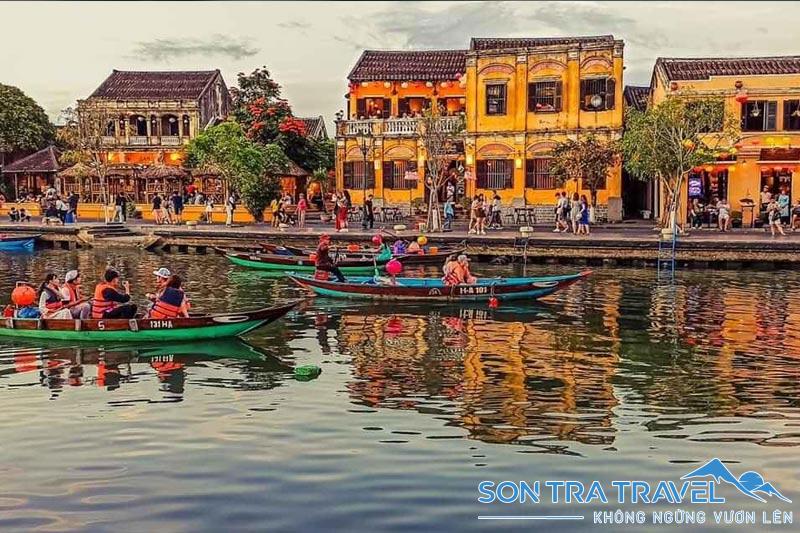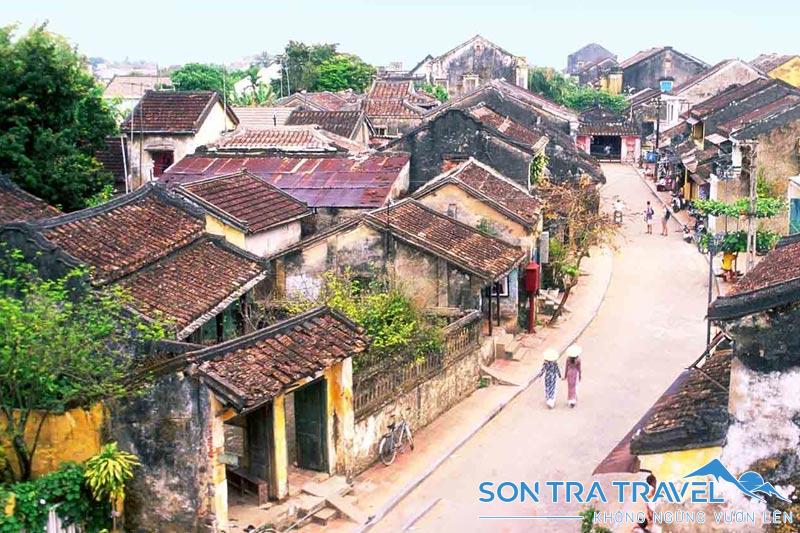Explore Hoi An ancient town
Hoi An ancient town is a famous tourist city of Quang Nam province, located entirely in Minh An Ward, downstream of Thu Bon River, in the coastal plain of Quang Nam province, Vietnam. About 30 km south of Da Nang city center, the East borders the East Sea, the South borders Duy Xuyen district and the West borders Dien Ban district. Another name for Hoi An
Another name for Hoi An
Few people know that before it was called Hoi An, this city also had another rather strange name, Faifo. This name may have started to be used by Portuguese merchants in the first half of the 16th century, and gradually became more popular in the 17th and 18th centuries. In a broad sense, Faifo means geographical space including estuaries, ports and wharves, markets, places where goods and products gather. In a narrow sense, Faifo is just the area that is today Hoi An Ancient Town. Entering the 17th century, Faifo almost became the official place name to talk about this trading port. The previous name Hoai Pho gradually faded over time and gradually changed to Hoai Pho. At the same time, the great name Hoi An appeared, and gradually it became the official name used and known to the whole world.
Entering the 17th century, Faifo almost became the official place name to talk about this trading port. The previous name Hoai Pho gradually faded over time and gradually changed to Hoai Pho. At the same time, the great name Hoi An appeared, and gradually it became the official name used and known to the whole world.
History of formation and development of Hoi An ancient town
Hoi An was born in the second half of the 16th century under the rule of the Le Dynasty. In 1527, Mac Dang Dung took over the Le dynasty and the Dong Kinh region at that time, taking control of the Mac dynasty. Then in 1533, Nguyen Kinh, in the name of the Le Dynasty, formed an army against the Mac Dynasty and after Nguyen Kim died, his son-in-law, Trinh Kiem, took power. In 1558, Nguyen Hoang - the third son of Nguyen Kim, his family and soldiers retreated to settle in the Thuan Hoa area. Also since 1570, Nguyen Hoang took control of Quang Nam and together with his son Nguyen Phuc Nguyen built a citadel, planned to develop the domestic economy, and expand trade with foreign countries (mainly Japan, China and some Western countries). Starting from here, Hoi An becomes the busiest international trading port in Southeast Asia.
In 1558, Nguyen Hoang - the third son of Nguyen Kim, his family and soldiers retreated to settle in the Thuan Hoa area. Also since 1570, Nguyen Hoang took control of Quang Nam and together with his son Nguyen Phuc Nguyen built a citadel, planned to develop the domestic economy, and expand trade with foreign countries (mainly Japan, China and some Western countries). Starting from here, Hoi An becomes the busiest international trading port in Southeast Asia.
What is special about Hoi An ancient town that makes it so attractive?
In 1999, Hoi An was officially recognized by UNESCO as a World Heritage Site. Since then, traveling to Hoi An to the old town has become a destination attracting a large number of domestic and foreign tourists. So, what makes this ancient city attractive?
Hoi An has impressive traditional architecture
Hoi An is famous for its traditional, harmonious architectural beauty of ancient houses, walls and roads. Although hundreds of years have passed through many events, this place still retains its ancient beauty, quiet and mossy on every tiled roof and row of trees. The house style here has a cool tubular architecture, filled with sunlight. The streets are arranged horizontally and vertically in a checkerboard style with short, winding streets embracing beautiful looking small houses. Walking around each small and peaceful street, visitors will definitely feel like returning to the space of hundreds of years ago, it brings comfort and gentleness.
The house style here has a cool tubular architecture, filled with sunlight. The streets are arranged horizontally and vertically in a checkerboard style with short, winding streets embracing beautiful looking small houses. Walking around each small and peaceful street, visitors will definitely feel like returning to the space of hundreds of years ago, it brings comfort and gentleness.
Hoi An has many typical monuments
There are many old towns here that were built in the 16th century and still exist today almost intact with more than 1,000 ancient architectural relics from streets, houses to temples, pagodas, ancient wells...  One of them is the Japanese Covered Bridge - a unique structure, an architectural feature imbued with Vietnamese architectural style. Not only was it chosen to be printed on the 20,000 VND bill, but it is considered a characteristic image and an invaluable asset of Hoi An.
One of them is the Japanese Covered Bridge - a unique structure, an architectural feature imbued with Vietnamese architectural style. Not only was it chosen to be printed on the 20,000 VND bill, but it is considered a characteristic image and an invaluable asset of Hoi An.
Hoi An ancient town has a rich culinary background
Introducing Hoi An ancient town, one cannot ignore the cuisine. The image of the old town is not only shown by houses, temples or ancient streets, but also a culinary paradise for foodies. Not only are the dishes rich and diverse, but all dishes have the typical flavor of this place. Even though it's just a small street, it takes a lot of time to enjoy all of Hoi An's specialties. These include chicken rice, Quang noodles, cao lau, bread, banh dap - stir-fried mussels, banh beo, banh vac, broth, sweet soup,... will definitely make you "nod" and praise its deliciousness.
Even though it's just a small street, it takes a lot of time to enjoy all of Hoi An's specialties. These include chicken rice, Quang noodles, cao lau, bread, banh dap - stir-fried mussels, banh beo, banh vac, broth, sweet soup,... will definitely make you "nod" and praise its deliciousness.
Hoi An has unique traditional festivals
Because it was once a busy commercial port and a place of exchange and trade with many different countries, Hoi An culture was also influenced by these countries. That has created different festivals, beliefs, and customs, like a highlight in the picture of Hoi An. Besides the indigenous customs and practices of the Vietnamese people, there are also customs and practices of the foreign resident community such as: rock worship and fish worship of coastal fishermen. In addition, Hoi An people also regularly organize festivals or other cultural and religious activities such as Tet Nguyen Tieu, Tet Thanh Minh, Doan Ngo, Mid-Autumn Festival, etc. Especially on the 14th and 15th full moon days of every lunar month. . Visitors to Hoi An also have the opportunity to experience folk activities: hut songs, drill songs, fake rice songs...
Besides the indigenous customs and practices of the Vietnamese people, there are also customs and practices of the foreign resident community such as: rock worship and fish worship of coastal fishermen. In addition, Hoi An people also regularly organize festivals or other cultural and religious activities such as Tet Nguyen Tieu, Tet Thanh Minh, Doan Ngo, Mid-Autumn Festival, etc. Especially on the 14th and 15th full moon days of every lunar month. . Visitors to Hoi An also have the opportunity to experience folk activities: hut songs, drill songs, fake rice songs...
Hoi An Ancient Town - City of titles
Hoi An with its timeless peaceful beauty, with cultural exchanges from many countries, with unique traditional festivals, with traditional ancient architecture,... All of this has helped it regularly appear. appeared in the polls of foreign visitors. Since becoming an attractive and world-famous destination, Hoi An city has excelled in many high positions in world tourism rankings, so much so that people call it the city of titles. , specifically:
The architectural features of Hoi An ancient town create a unique image that attracts tourists
There are no high-rise buildings with modern designs. The popular house style here is one or two-story townhouses with a narrow width but a very long and deep length, creating a tubular house style.
The materials used to build houses have high strength and durability. Normally, a house in Hoi An will have a typical structure of a wooden frame house, with two sides separated by brick walls. The width of the house is only about 4 - 8 m wide, the depth is 10 - 40 m. The layout will include: sidewalk, porch, main house, outhouse, porch, toilet, 3-room back house, garden. Although small, it is airy and filled with sunlight.
The architectural style of houses in Hoi An ancient town lies not only in the design of the house shape but also in the tiled roof. Most of them are roofed in the form of two roofs, the main house and the outhouse do not share the same roof but are two adjacent roofs. Very few government roofs cover the outbuildings. When roofing, people will arrange a row of tiles facing up, followed by a row of tiles facing down. After roofing, the tiles will be fixed with tape, forming a strip of tiles rising along the roof. This makes the entire tile roof look sturdy and strong.
The roof is built high in a rectangular shape like a box. Overall, it seems unbalanced, but this decoration makes Hoi An's house impressive, creating the unique beauty of this city.
Covered Bridge - historical relic of the old town
Every time Hoi An ancient town is mentioned, this project certainly cannot be ignored. Japanese Covered Bridge, also known as Japanese Covered Bridge, is a unique and typical architectural work here. The pagoda was built by Japanese merchants who came here to trade in the mid-16th century. Due to the impact of natural disasters and epidemics, the pagoda has undergone many restorations, gradually losing Japanese architectural details. Instead, it has Vietnamese-Chinese architectural features. The pagoda has a Cong shape, the bridge is made of curved wooden planks spanning the creek through the Hoai River. The car's roof curves softly and is carved with many sophisticated motifs. On the side of the bridge there is a small temple worshiping the North God Tran Vu. At both ends, there are two groups of wooden statues of monkeys and dogs. This is a prominent tourist attraction and also a virtual check-in point for many tourists.......
The pagoda has a Cong shape, the bridge is made of curved wooden planks spanning the creek through the Hoai River. The car's roof curves softly and is carved with many sophisticated motifs. On the side of the bridge there is a small temple worshiping the North God Tran Vu. At both ends, there are two groups of wooden statues of monkeys and dogs. This is a prominent tourist attraction and also a virtual check-in point for many tourists.......


































